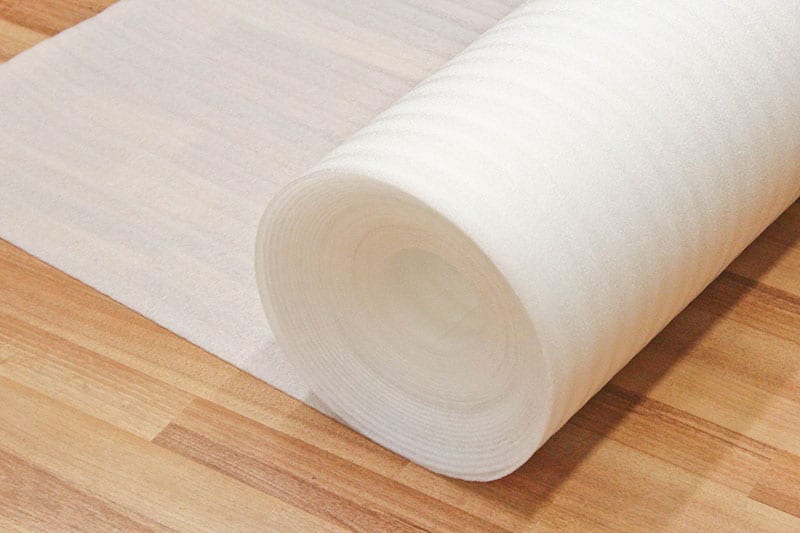This post contains affiliate links.
Underlayment is required when installing laminate flooring as it plays a very important role in the whole laminate flooring system. It provides stability and support to the floating floor, helps hide some of the minor imperfections of the subfloor, sometimes also acting as a moisture barrier, and also limit sound transmissions between the rooms below and above the floor. Using only one layer of underlayment is the normal practice when installing laminate flooring but is it possible to use two layers to double the effects of its properties?
Can you use two layers of underlay under laminate flooring? It is not recommended to use more than one layer of underlayment under laminate flooring as it can make the flooring too soft and unstable, and can cause the joints to dislodge, or its locking system to break. You also risk voiding the warranty of the laminate flooring.
What about laminate flooring with a built-in underlay underneath? Can you install a separate roll of underlayment under laminate with an already attached underlay or padding?
Never put underlayment under laminate with built-in padding underneath. It has the same effect as using two layers of underlay and will cause the floor to be too soft and unstable which can cause the joint locking system to dislodge or break apart. Your laminate warranty could also get voided.
Using more than one layer of underlayment may also cause soft spots or spongy areas to happen on your laminate floor. You can read more about it in this article.
Whatever the reasons are why you would want to use two layers of underlayment, or extra padding underneath your laminate flooring, there are better ways to address these concerns.
What Is the Underlayment for Laminate Floors For?
Before we go through some of the better alternatives to some of the reasons why one would consider using two layers of underlayment under laminate flooring, let’s first talk about what an underlayment is for.
An underlayment is placed over a subfloor before laying down laminate. Its main purpose is to provide a smooth surface, which most subfloors can’t provide, for laminate to float on. It also has some degree of sound barrier and some also act as a moisture barrier for ground and below-grade floors.
Underlayment is normally around 2 – 3mm or around 1/8″ thick and should only be installed as a single layer. If the laminate floor already has an underlayer attached underneath it, you no longer need to provide a separate underlayment as discussed above.
Can You Install Laminate Without Underlayment?
You can’t install laminate directly on a subfloor without an underlayment and you can void your warranty if ever you did so without it. Without an underlayment, the friction between the laminate and the subfloor can wear and damage the laminate faster.
So what could be a reason why some people are considering using two layers of underlayment under laminate floors? Here are some of them below:
- To address an uneven subfloor, thinking that two layers or a thicker underlayment can correct it.
- To raise the floor to a certain height.
- To improve the acoustics of the floor.
Using more than one underlayment is not a good solution to address these concerns, and will only be detrimental to the flooring.
Better Alternatives to Using Two Layers of Underlayment Under Laminate Flooring
If you can’t use two layers of underlayment to address the concerns listed above, then what can you do to address them?
Correcting an Uneven Floor for Laminate
You found out that you have an uneven floor and you know that laminate flooring needs a smooth and level floor to install properly. If you can’t use more than one layer of underlayment to level the floor, what can you do to correct it?
Here are several options for both concrete and wood subfloors:
- Add a layer of concrete topping or cement screed over a concrete floor. It can be from 25mm to 50mm (1″ – 2″) thick. This is ideal for rough concrete floors with extreme imperfections. Leveling it will require some skill or professional help to be able to do this properly.
- Use a self-leveling compound. It’s similar to a cement screed but it is usually applied thin. It is a fast-curing and flexible solution that will automatically level itself until it hardens. It is best used for concrete floors with shallow roughness or minor imperfections. Some self-leveling compound can also work with a plywood subfloor as well.
- Install a plywood base over the uneven floor. You can do this for both concrete or wood type subfloors. Depending on how uneven the floor is, the plywood base could be as thin as 3mm or 1/8″ or as thick as 12mm or 1/2″.
If your floor is extremely uneven or slanted, there might be a structural problem that needs to be addressed. For this kinds of cases, it is best to consult a professional.
Raising the Floor for Laminate Flooring
For instances where you need to raise the floor a certain height, like when an adjoining flooring is higher than the floor where you’re installing the laminate, and the laminate thickness is not enough to get to that specific level, don’t address it by using more than one layer of underlayment.
Here are some of the things you can do instead:
- Add a layer concrete topping or cement screed for concrete floors. This is pretty much the same as how you would use it to correct an uneven floor. You can add an additional height of 25mm – 50mm (1″ – 2″) to the floor. Make sure to take into account the thickness of the laminate and underlayment when you compute the exact height of concrete topping or cement screed to add.
- Add a layer of plywood base over the subfloor. You can do this for both concrete or wood subfloor types. The thickness to use will depend on how high you want to raise the floor. You can also do double layers of plywood if you need it to be thicker. Also, when you compute for the exact thickness of plywood to use, take into account the thickness of the laminate you’ll be using and its underlayment.
Improving Acoustics of Laminate Floors
All underlayments offer some level of acoustic property and add some degree of sound barrier between the space below and above the floor. Each underlayment has a different noise reduction property though and with some being better than others.
If you want your laminate flooring with better noise reduction property, then go for a premium underlayment with a high STC and IIC rating. Also, use a laminate without an attached underlayment so that you can choose and use a better underlayment.
Most standard foam underlayment only offers minimal impact and noise reduction. There are manufacturers, however, that carries underlayment products with better noise and impact reducing properties. Some of these underlayments often have the standard foam base with additional materials, such as a polyethylene or aluminum foil layer, that increases its STC and IIC rating.
Since underlayments usually are thin, even with products specifically made with better noise and impact reduction, they can only do so much to improve the acoustics of the room or to prevent sound between the spaces below and above the floor from passing through.
One of the ways to improve the acoustics of the floor is to add and insulation, such as fiberglass or mineral wool, filling all the gaps in between the floor joists, between the floor and the ceiling below.
General Types of Underlayment for Laminate Flooring
Here’s a short guide to the different types of underlayment that are available to use for laminate flooring.
Pre-installed Underlayment
Pre-installed underlayments are underlayments that come pre-attached or pre-installed underneath laminate flooring. They are usually 3mm or 1/8″ thick. They normally can’t function as a vapor barrier and you would usually need to add a separate layer of moisture barrier when you use this on ground or below-ground level floors.
Standard Underlayment
Standard underlayment are usually around 2mm – 3mm or around 1/8″ thick. It is available in foam, cork, or felt materials. They don’t have built-in moisture barrier and you would need to add a separate layer of moisture barrier when using this over floors on ground or below-grade levels.
Combination Underlayment
Combination underlayment offers more than one function. They are sometimes called 2-in-1 or 3-in-1 types. Most of them are premium types that has a built-in moisture barrier and also offers better noise and impact reduction properties.
All About Materials is a participant in the Amazon Services LLC Associates Program, an affiliate advertising program designed to provide a means for sites to earn advertising fees by advertising and linking to Amazon.com. We also participate in other affiliate programs which compensate us for referring traffic.

